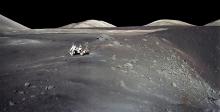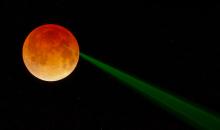Listen to today's episode of StarDate on the web the same day it airs in high-quality streaming audio without any extra ads or announcements. Choose a $8 one-month pass, or listen every day for a year for just $30.
You are here
Moon and Regulus
While exploring the gray lunar landscape 50 years ago this week, the crew of Apollo 17 saw something amazing:
SCHMITT: There is orange soil! It’s all over! Orange! Fantastic, sports fans. CERNAN: How can there be orange soil on the Moon?
Geologists wondered the same thing. So Jack Schmitt and Gene Cernan brought some of it to Earth for study. Scientists found the orange came from beads of volcanic glass, probably blasted from a big eruption more than 3.6 billion years ago.
In 2011, scientists looked at the samples again, using tools that weren’t available when Apollo 17 ended. They found that the beads contained a lot of water — the same percentage found in Earth’s mantle — the layer below the crust. It suggests that, even though the lunar surface is dry, the Moon’s insides could’ve had as high a concentration of water as the interior of Earth.
Scientists aren’t through with the Apollo 17 samples yet. They just opened some of them this year for the very first time. The samples had been stored in pristine condition, awaiting the development of new tools — perhaps leading to more discoveries from a 50-year-old mission.
The Moon climbs into good view by 11 p.m. About two-thirds of the hemisphere that faces our way is in daylight, so it’s nice and bright. Regulus, the lead star of Leo, rises to the lower right of the Moon, and is below the Moon at first light.
More about Apollo 17 tomorrow.
Script by Damond Benningfield






